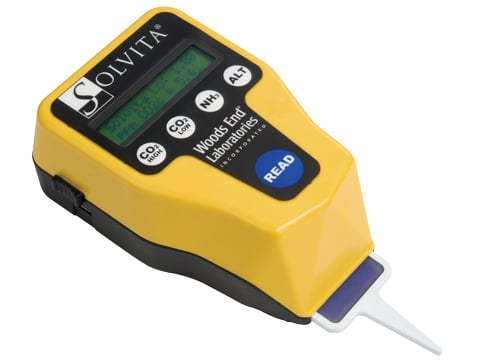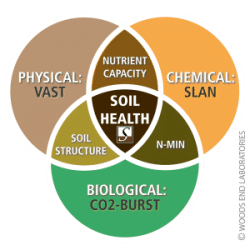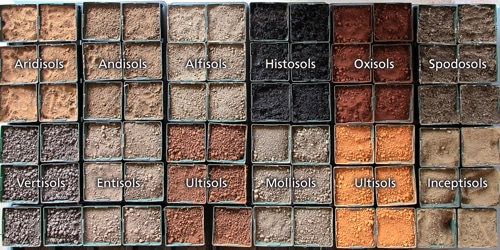About Us
Setting Present-Day Standards
MISSION
Solvita’s mission is to increase awareness of soil biology functions by providing simple, accurate tools for performing measurements in the field and laboratory.
Solvita® Timeline
PIONEER PHASE:
After the invention of the Solvita gel detector, Woods End labs collaborated with John Doran’s (USDA-ARS) soil quality lab (Univ. of Nebraska) to develop interpretation guidelines for field use of respiration. This contributed a foundation to understand the relationship among existing methods for soil respiration. The Soil Quality Institute lists Solvita under soil respiration procedures (). More recently, USDA expanded the information base to a for field use of the Basal Solvita test, a field procedure that enables one to measure native soil respiration.

“QUANTITATIVE” PHASE:
After 2001 a new phase occurred in quantifying Solvita respiration which was originally a visual color-system. Quantification required development of a cost-effective photometric device to read the optical response of Solvita gels when excited by LED light in the presence of CO2. This project was successful with the development of a low-cost . Further standardization effort was undertaken to create a reproducible method for commercial labs based on the “CO2-Burst” phenomena – this occurs when dry soil is moistened and microbes “burst” into activity. The ideal for soil respiration is to use fresh, un-dried and non-milled samples. It is still not known how much of the CO2-burst is a result of soil disturbance, and since labs are not being monitored as to the intensity of soil-grinding practices, this is likely to remain an unknown for some time. All methods continue to evolve and should lead to improvements for soil handling and methods of wetting soil conducive to soil biology. It is now believed that common soil lab practices of intensively grinding soils, a method which helps “get nutrients out” also falsifies soil biology by disrupting the microbial – bio-physical environment. This has led Solvita to upgrade methods required for accurate biology representation.
SOIL HEALTH PHASE:
Solvita belongs to a “soil health” growth phase in farming where continued work with cooperating laboratories, universities and farmers is helping establish Solvita tests as useful cornerstones for accurate and cost-effective soil biology testing. The development of the including SLAN, a test for soil amino-N, plus VAST – a rapid test for aggregate stability – enables labs to offer evaluations of soil traits long ignored by conventional testing but best represented by ‘triangulating” differing methods. By combining the CO2+SLAN test with Woods End’s new aggregate stability test (VAST) any lab may offer an integrated Soil Health Evaluation, similar to other soil health test programs, but cost effective for commercial farming.
SOLVITA® SOIL HEALTH PROFICIENCY PHASE:
With new international focus shifting to alleviating soil degradation, methods such as Solvita which cost-effectively evaluate soil quality, come under more scrutiny. Therefore in 2016 Woods End Labs launched a using soils of known traits which have been specially prepared for optimizing soil biology tests. In contrast to the USA proficiency programs in which the original quality-structural traits underlying healthy functioning of soils are compromised by crushing, hammer-milling and sieving, ostensibly to improve “nutrient extraction”, the Solvita program warrants minimal dis-aggregation and minimal structural loss of soil samples, prior to performing soil health tests. Commercial soil labs can subscribe to the sample program and receive a “score card” on performance and have Solvita equipment internally monitored to maintain quality. These efforts are intended to build awareness for QAQC in soil biology and to enable labs to more rapidly adapt to improved methods.
Applications of Solvita®:
Solvita® technology was created by Drs. Brinton and Droffner, two scientists possessing decades of experience in environmental biology and chemistry. The patented gel-technology system is a basic visual color system, and all Solvita kits work with this color system. Their goal in this innovation was to revolutionize the field of biological respiration testing, especially for soil studies. The global relevancy of carbon cycling in soils and decomposing organic matter provides the basis for new perspectives in measuring gaseous emissions.
Solvita has advanced across several markets and is inspiring soil conservationists, farmers, grain processors and composters in new ways to gauge the quality of their environment.
Solvita yields a truly practical and cost-effective means to perform tests previously conducted only by more elaborate lab set up.
It can be used for a variety of applications:
- For biological activity of soils: and
- For
- For
- For
- For
- For



